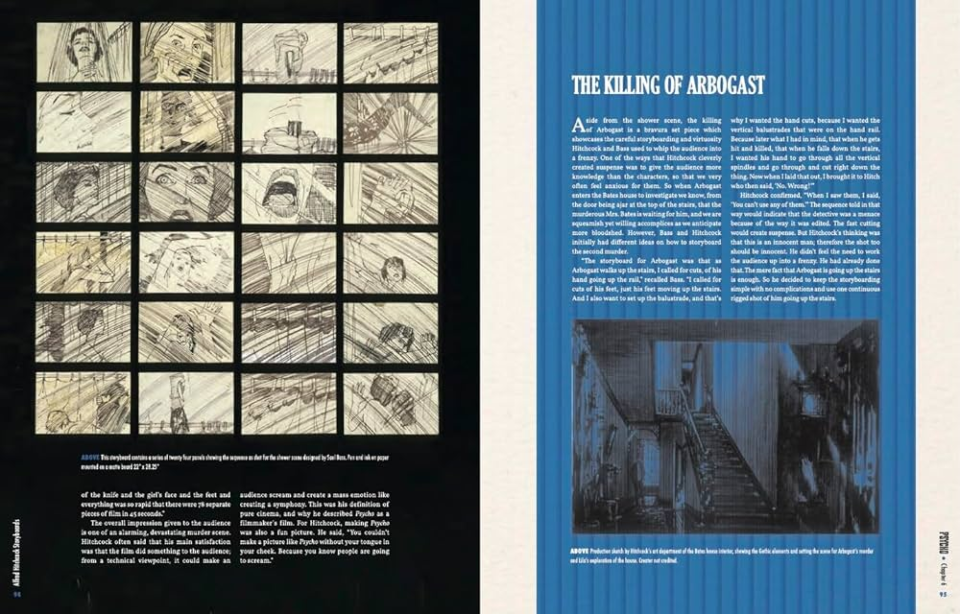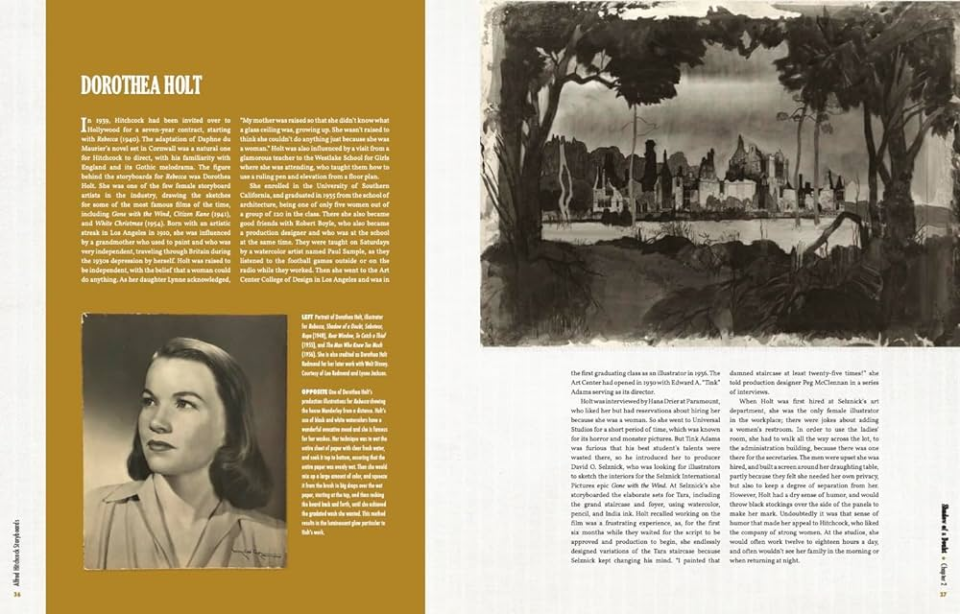‘Alfred Hitchcock Storyboards’ Review: A Gorgeous Look Into The Mind of A Horror Master

Alfred Hitchcock expressed himself through a refined and unique visual language, which he often referred to as “pure cinema” or “filmed emotion”. In his latest book Alfred Hitchcock Storyboards, award-winning writer and Hitchcockian Tony Lee Moral takes us on a tour across a thoughtfully chosen selection of films, allowing readers to track the significance of storyboarding throughout the director’s career. Perfect for coffee tables everywhere, this book shines a light on early works including the much beloved The 39 Steps and Hitchcock’s own favorite Shadow of a Doubt. Don’t worry, it also highlights the big hitters such as Psycho, North by Northwest, and The Birds as well as a particularly enlightening look at one of Hitchcock’s final films, Torn Curtain.
Each of the nine chapters contains an overview of the cast and crew, a plot summary, and creative spotlights whilst taking time to explore the techniques, influences, and those involved. This is all ideal accompaniment to the main attraction which is the glorious illustrations. The size and design choices made for the book mean that what it lacks in portability, it more than makes up for in allowing for close enjoyment and immersion of the bounty of sketches, production photographs, shooting scripts, concept illustrations, and matte designs, some of which have never been published before. As such, this artistic and illustrative odyssey is the perfect way to explore the artwork and processes that led to some of the most memorable films in cinematic history.
Also Read: Four Films That Perfectly Capture the Essence of Alfred Hitchcock
Hitchcock’s predilection for storyboarding is no secret. In fact, it is often remarked upon how he considered a film complete once this stage of work was over and famous accounts of him falling asleep onset have circulated for decades. As such, the contribution made towards his films through the storyboarding process cannot be overlooked or underestimated and what makes this such a heartening read is Moral’s clear dedication to championing the integral role they played in the directors’ success. As the writer observes in the early pages of his book, “storyboarding is where the creative work and the heart of the engine took place.”

One of the remarkable discoveries of Alfred Hitchcock Storyboards is being made aware of the breadth of information storyboards communicate and convey with Moral devoting space to consider all aspects of this, from tone and atmosphere, to mood and lighting and the position of the camera. Although there is a fair amount of detail on the technical aspects of filmmaking, this is always presented clearly and with the intention of being understood. Not once does it stray into becoming overwhelming or alienating. Elsewhere, there are fascinating insights into the artistic process and the use of inks, paints, and more, charting the fascinating journey of translating images from creative minds onto the screen to give breath and life to a Hitchcockian vision.
Also Read: ‘Birdemic 3’ Director On His Alfred Hitchcock Connection
Although the book might bear the name Hitchcock within its title—and while Moral acknowledges the inspiration and infectiousness of a director who communicated his vision clearly to those who supported him—it is, at heart, a book that celebrates the collaborative spirit of filmmaking. A quote from Joseph Musso who storyboarded on Torn Curtain demonstrates how much value the director placed in his artists and in the storyboarding process. “Hitchcock,” he remarks, “liked to have an illustrator in his pocket.”
Easily the most fascinating aspect of the 144-page book—with the exception of the illustrations and artwork which are its beating heart—are the spotlights within each chapter dedicated to the too often-unsung artistic genius and skill of those central to the storyboarding process. This includes names that may likely be familiar to Hitchcock fans such as Henry Bumstead and Robert Boyle whose contributions to masterpieces such as Vertigo and North by Northwest will remain memorialized on the screen forevermore.
Of interest and note is Moral’s attention to Dorothea Holt who worked on no less than seven Hitchcock films. As one of few female storyboard artists working at the time, her tale is one of the book’s highlights. Her independence, drive, and dedication to the craft produced a career including the creation of designs that are firmly and fondly etched into our memories such as the grand and foreboding palatial Manderley of Rebecca through her gorgeously gothic watercolors and the neighborhood apartments of Rear Window.

Also Read: Tarantino Praises This ’70s Chiller as a “Hitchcock homage”
The book takes care to devote the greater portion of its pages to showcasing the storyboards, sketches, and designs, including unforgettable drawings by Hitchcock himself such as the famously suspenseful Statue of Liberty Scene from Saboteur. Interwoven with the authors’ insights and analysis are the recollections, and anecdotes of those involved or related to those who helped create the wonderfully entertaining and eternally ambiguous Hitchcockian universe. These rare and precious accounts paint wonderful visuals of their own, adding color and intimacy to the reading experience.
While this book is, in many respects, an act of looking back in time, Moral also offers food for thought by pausing to consider the present and the future, too. This is done through an interesting assessment that, if anything, whets the appetite for a little more. He discusses the role of storyboarding in the industry today as well as what TikTok and Instagram creators might stand to learn from both the director and the storyboarding process.
Also Read: ‘Road Games’ is a Must-See Hitchcockian Chiller [Watch]
Moral’s writing style is a perfectly balanced combination of eloquence and accessibility, meaning that the audience for Alfred Hitchcock Storyboards is universal and the possibilities open to readers for learning, absorbing, and reflection are rewardingly far-ranging. With three previous Hitchcock-focused books under his belt, Moral does not need to prove his expertise (nor his passion). But the former is clearly evidenced while the latter simply radiates throughout in a way that fellow enthusiasts will identify with and newcomers will readily enjoy.
Alfred Hitchcock Storyboards opens with an exquisite quote from the Master of Suspense himself: “There is a rectangle up there-a white rectangle in a theatre-and it has to be filled.” A visual-feast-filled delight, overflowing with surprises and wonderful articulations at the turn of every page, Moral’s book acts as a fitting response to this typically erudite statement from the Master of Suspense. For cinephiles, filmgoers, and Hitchcockians alike, Alfred Hitchcock Storyboards offers an unparalleled visual treat to pour over with great enchantment and surrender.
Alfred Hitchcock Storyboards will be released on February 6, 2024, through Titan Books.
Listen to Rebecca’s podcast Talking Hitchcock on Apple and Spotify.
Summary
For cinephiles, film goers and Hitchcockians alike, Alfred Hitchcock Storyboards offers an unparalleled visual treat to pour over with great enchantment and surrender.
Categorized:Reviews

